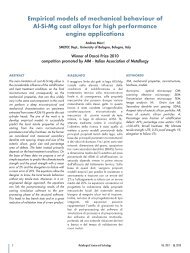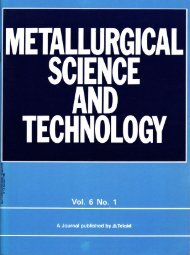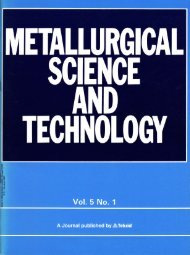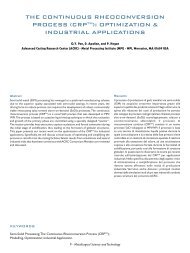PDF, about 5Mb - Teksid Aluminum
PDF, about 5Mb - Teksid Aluminum
PDF, about 5Mb - Teksid Aluminum
Create successful ePaper yourself
Turn your PDF publications into a flip-book with our unique Google optimized e-Paper software.
added in the form of Al-10%Sr master alloy at a<br />
level of 150- 200 ppm.<br />
Sand and gravity die casting<br />
The sand moulds used were made by hand. As a<br />
pattern, a fan blade cast in a gravity mould was<br />
used, which is as already mentioned, one of the<br />
methods normally used to manufacture this size<br />
and type of fan blade. The sand mould consisted<br />
of chemical bonded sand.<br />
Gradient solidification<br />
The same alloy as that used for the sand and gravity<br />
die cast components, shown in table 1, was cast<br />
into rods for further solidification studies<br />
in the gradient solidification equipment. The<br />
gradient solidification technique allows the<br />
production of a high quality material with a low<br />
content of oxide films, porosity and shrinkage<br />
related defects, and produces a homogenous and<br />
A)<br />
well-fed microstructure throughout the entire specimen. In this work a<br />
resistance-heated furnace with an electrically driven elevator was used, see<br />
figure 2a. Three different growth velocities, v, were used, 0.03 mm/s, 0.3<br />
mm/s and 3 mm/s, which correspond respectively to an SDAS of <strong>about</strong> 50,<br />
20 and 7 µm. At each velocity, three specimens were made. The specimens<br />
cast in the gradient solidification equipment were protected by argon in<br />
order to avoid oxidation.<br />
Thermal analysis<br />
In order to study the thermal history of the solidified components,<br />
thermocouples were inserted at three different positions in the sand cast<br />
fan blade, as indicated in the picture in figure 1. To record the cooling curves<br />
a data acquisition device from National Instruments was used. In each of<br />
the sand moulds three thermocouples were placed. The thermocouples<br />
were of S-type, which means that the different materials in the thermocouple<br />
wires are platinum and platinum-rhodium (90Pt-10Rh). When manufacturing<br />
the thermocouples, the wires are inserted in a two-hole Al 2 O 3 -tube to<br />
separate the wires, which are connected to a plug. The thermocouples<br />
were protected from the molten metal by a quartz glass tube. The maximum<br />
operating temperature for the S-type thermocouple is over 1500°C [1].<br />
The recording rig is illustrated in figure 2b.<br />
B)<br />
Fig. 2: . Illustration of the instruments that have been used during the investigation. While a) demonstrates the gradient solidification equipment,<br />
b) presents the data acquisition rig that is connected to the sand moulds.<br />
14 - Metallurgical Science and Technology







